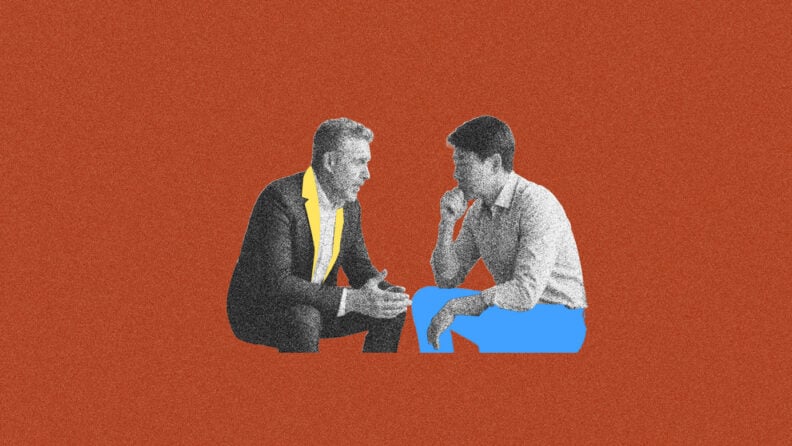A CEO called me with a serious tone in his voice.
“If this VP doesn’t change his conduct, I’ll have to fire him. And that will be the hardest decision since we co-founded this company.”
“What happened?” I asked.
“He’s killing his people. He doesn’t listen. They’re afraid to speak up. They feel their ideas and concerns aren’t heard. He’s never satisfied with their work. But I’ve known him from the beginning—he’s a big part of why we’ve succeeded. I don’t know what to do. Danny, can you work with him?”
Challenge Accepted
The VP in question was open, willing to reflect, ready to listen. I coached him, facilitated difficult conversations between him and his team, and encouraged him to take responsibility without becoming defensive. Progress was slow but steady.
To support the process, I set joint meetings with the CEO and the VP. In one of those sessions, the VP tried to explain his perspective, but the CEO abruptly cut him off. The VP, visibly offended, shut down and couldn’t continue. The meeting hit a wall. I called for a break, to let the VP cool down.
During the break, I gently approached the CEO and urged him to reflect on the impact of his behavior.
“You’re making him shrink,” I said. “This isn’t helping the process.”
He paused, then said something that truly surprised me: “I guess I’m doing to him exactly what I asked him to stop doing to his team.”
Would he be willing to say that out loud when the VP returned? The CEO agreed.
The VP re-entered the room, his expression tense and withdrawn. Without hesitation, the CEO said, “You know, I just realized that what I did to you before the break is exactly what I’ve been asking you not to do to your people. I didn’t listen to you, I shut you down. And I see now, I’ve been doing it to you all along. I take full responsibility for that.”
That moment changed everything. It was pure vulnerability - two leaders, stripped of their defenses, facing each other with honesty and humility.
The emotional impact was so strong, they were nearly in tears. There was nothing more to explain. The CEO’s admission was enough. Trust began to rebuild in that very moment, setting the tone for their renewed partnership, paving the way for deeper trust across the organization.
This story highlights a hidden but critical dynamic at the heart of leadership: the power of vulnerability and the willingness to admit mistakes and take responsibility.
These are not signs of weakness, they’re the foundation of trust. And trust is what makes it possible for people to bring their full selves to work. Without that foundation of trust and safety, people feel overwhelmed and disconnected and ultimately, they cannot truly belong.
Without a true sense of belonging, real engagement simply cannot happen.
From Vulnerability to Belonging
This dynamic reflects what I call The Belonging Paradox—the tension between our deep need to be part of a group and our equally vital need to remain true to ourselves.
When fitting in requires us to shrink or hide essential parts of who we are, trust breaks down. But when leaders foster environments where people feel both included and free to be authentic, belonging becomes a source of strength, not compromise.
This paradox is at the heart of many breakdowns in teams, organizations, and societies. It’s also the key to repairing them.
Hard to Speak Up
Under pressure to deliver quarterly results and outperform competitors, leaders often push for performance at the expense of connection. Teams feel the heat and are expected to hit targets without being fully heard.
In this environment, employees often silence their unique voices and focus on compliance over creativity. This is especially true when their input challenges the status quo. Trust erodes, and a sense of disconnect grows.
True belonging requires more than just being part of a team, it means being seen and valued for who you genuinely are. But in many organizations, employees feel they must ‘cover’ parts of themselves to succeed. When leaders prioritize output without fostering space for authenticity, trust is lost.
As Gallup’s State of the Global Workplace surveys repeatedly show (in 2024, only 21% of employees are engaged), this isn't rare. Employees quickly sense what is safe to express and when they feel unheard or invisible, they pull back. Not from apathy, but from a calculation. Speaking up doesn’t feel safe or worthwhile.
Scaling Trust
I was called in to assist a global high-tech company: trust was rapidly eroding between top management and the next leadership tier.
Tensions had built up over repeated crises such as product delays, missed targets, and public setbacks, each followed by a familiar pattern: blame trickled downward while accountability at the top remained vague. Frustration simmered. Executives in the lower ranks felt they were being constantly thrown under the bus.
To address this, I designed a leadership conference. Not another strategy offsite, but a space to confront these dynamics head-on. I asked a few senior executives to do something bold: present real case studies of major missteps, complete with what they had learned and what they now regretted.
When the first executive stood up and admitted, “We dropped the ball, and it cost the company millions," you could hear a pin drop. The room went still. People leaned in. For the first time, vulnerability wasn’t just encouraged—it was demonstrated.
That moment cracked something open. As the stories unfolded, so did the people in the room. Defensive body language gave way to nods of recognition.
Impact of vulnerability
In the days and weeks that followed, something subtle but unmistakable shifted. Meetings grew quieter, but more honest. Feedback started flowing in both directions.
That experience opened my eyes to how vulnerability at the top can unlock belonging throughout the organization.
When senior executives stood up and took responsibility for past mistakes, they sent a powerful message: “You don’t need to be perfect to be valued here.”
That moment broke the illusion that leadership is about always being right and made space for others to bring their full, imperfect selves to the table.
Instead of blame rolling downhill, what emerged was honesty. That shift unveiled layers of mistrust and created an environment where people felt psychologically safe, no longer needing to hide their fears, ideas, or doubts.
This is the heart of the belonging paradox: people want to contribute meaningfully to a shared mission, but not when it means suppressing who they are. The leaders’ public admission of fallibility gave permission for authenticity at every level. It wasn’t just an act of humility, it was a cultural signal that real belonging starts with being real.
Applying Vulnerability
Here are practical steps leaders can take:
- Admit Mistakes: Openly admit your own errors and highlight lessons learned from them.
- Encourage Authentic Dialogue: Reward honesty, even if uncomfortable, rather than polite silence.
- Model Vulnerability: Regularly share personal insights or challenges to humanize leadership.
- Create Safe Spaces: Establish forums or rituals where candid conversations can safely happen.
The belonging paradox doesn’t demand a trade-off between results and realness, it calls for leadership that is strong enough to be human. When authenticity is modeled from the top, trust deepens, people feel truly seen, and genuine belonging becomes possible.
What's Next?
Want more insights and inspiration? Sign up for the People Managing People newsletter and you'll get all the latest expert tips, trends analysis and insights from leading HR professionals delivered straight to your inbox.





